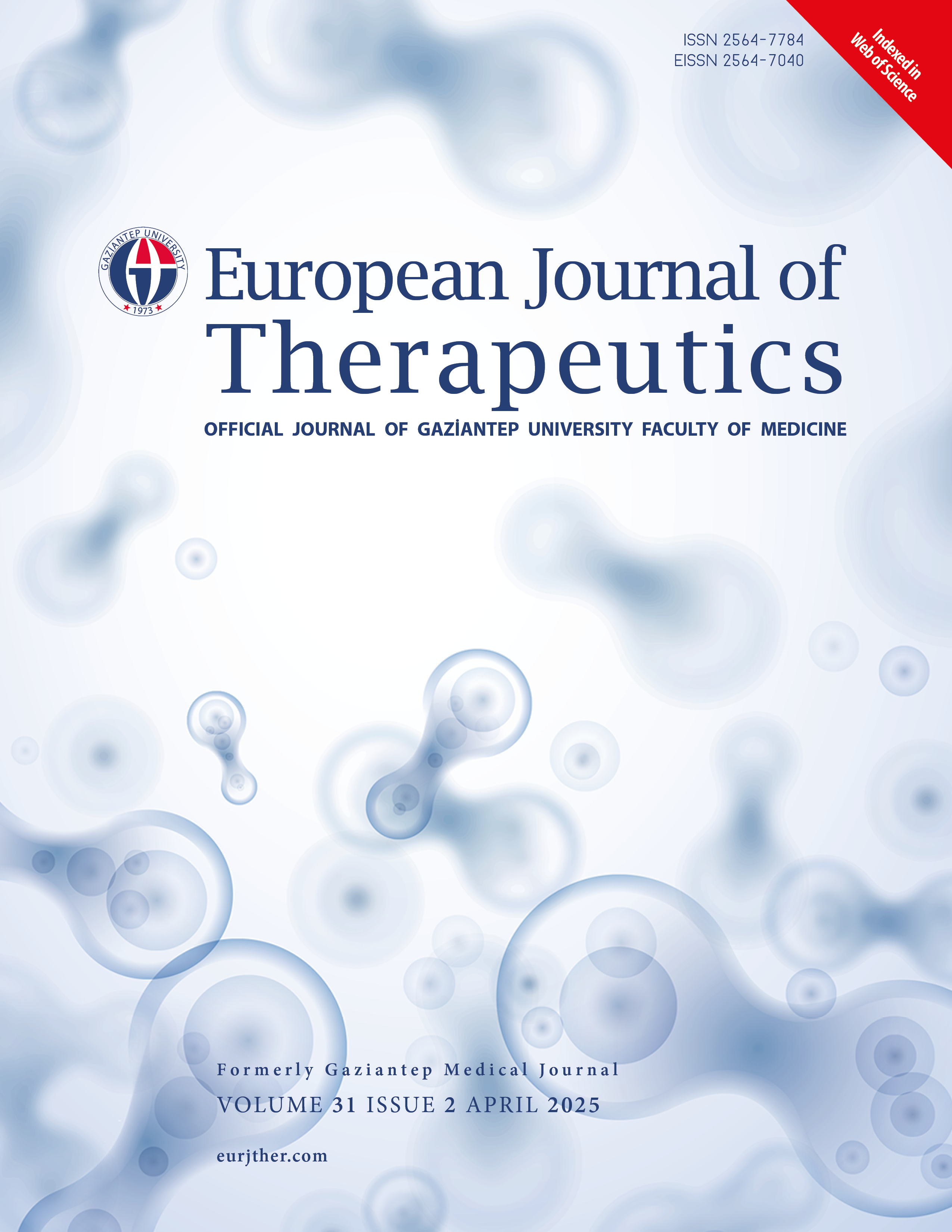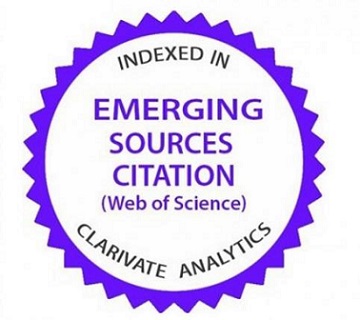The Morphological and Morphometric Examination of the Asterion in Terms of Surgical Approaches to the Posterior Cranial Fossa
DOI:
https://doi.org/10.58600/eurjther2621Keywords:
asterion, morphology, morphometry, cranial anatomic landmarks, posterior cranial fossaAbstract
Objective: The asterion is an important cranial anatomical landmark used in surgical approaches to the posterior cranial fossa, which is one of the most complex and surgically challenging regions of human anatomy due to the density of neurovascular structures. This study aims to examine the morphological and morphometric variations of the asterion to determine its preoperative localisation and help neurosurgeons reduce possible complications by providing an understanding of the detailed anatomy of the asterion in surgical approaches applied in posterior cranial fossa pathologies.
Methods: In our study, adult human dry skull specimens (44 intact, 104 hemi skulls) with unknown demographic data were analysed. The asterions were first examined morphologically and categorised into two classifications. These classifications were based on the presence of wormian bone and the distance from the Frankfurt horizontal plane (FHP). Morphometric measurements were based on anatomical landmarks in the human skull. The landmarks used in the measurements were the lambda (L), FHP, the root of the zygomatic arch (RZA), the tip of the mastoid process (TMP), Henle’s spine (HS), external occipital protuberance (EOP), basion (B), opisthion (O) and porion (P).
Results: The morphological classification of the asterions was examined. Type 1 and Type 2 were determined as 13.02% and 86.98%, respectively, according to the presence of the wormian bone. In the classification, according to the distance to the FHP, Type 1 was 9.90%, Type 2 was 58.85% and Type 3 was 31.25%. In morphometric measurements, the mean distance of the asterion to L was 85.16 ± 5.64 mm and 84.41 ± 5.43 mm on the right and left sides, respectively. The mean distance of the asterion to the FHP was 13.17 ± 6.81 mm and 14.01 ± 6.96 mm on the right and left sides, respectively. The mean distance of the asterion to the RZA was 56.18 ± 3.58 mm and 56.64 ± 3.69 mm on the right and left sides, respectively. The mean distance of the asterion to the TMP was 49.42 ± 4.16 mm and 48.91 ± 4.03 mm on the right and left sides, respectively. The mean distance of the asterion to HS was 46.15 ± 3.74 mm and 46.69 ± 3.79 mm on the right and left sides, respectively. The mean distance of the asterion to the EOP was 63.19 ± 4.13 mm and 62.71 ± 4.07 mm on the right and left sides, respectively. The mean distance of the asterion to B was 73.50 ± 3.73 mm and 72.96 ± 3.51 mm on the right and left sides, respectively. The mean distance of the asterion to O was 62.46 ± 2.88 mm and 62.23 ± 2.85 mm on the right and left sides, respectively. Finally, the mean distance of the asterion to P was 49.51 ± 3.87 mm and 50.32 ± 3.94 mm on the right and left sides, respectively.
Conclusion: The results obtained in our study suggest that the accurate preoperative positioning of the asterion may contribute to reducing complications that may develop in neurosurgeons’ surgical approaches to the posterior cranial fossa.
Metrics
References
Standring S (2021) Gray’s Anatomy: The Anatomical Basis of Clinical Practice, 42nd edn. Elsevier Limited.
Ucerler H, Govsa F (2006) Asterion as a surgical landmark for lateral cranial base approaches. J Craniomaxillofac Surg. 34(7):415-420. https://doi.org/10.1016/j.jcms.2006.05.003
Akkaşoğlu S, Farimaz M, Akdemir Aktaş H, Ocak H, Erdal ÖD, Sargon MF, Çalışkan S (2019) Evaluation of Asterion Morphometry in Terms of Clinical Anatomy. Eastern J Med. 24(4):520-523. https://doi.org/10.5505/ejm.2019.50480
Fang B, Chen G, Wang L, Zhu X, Qiang HU, Zhang J (2016) Skull anatomic landmarks for retrosigmoid craniotomy in a Chinese cohort: a 3D-computed tomography study in vivo. Turk Neurosurg. 26: 564–567. https://doi.org/10.5137/1019-5149.JTN.9187-13.0
Day JD, Tschabitscher M (1998) Anatomic position of the asterion. Neurosurgery. 42(1):198-199. https://doi.org/10.1097/00006123-199801000-00045
Couldwell WT (2018) Skull Base Surgery of the Posterior Fossa, 1st edn. Springer International Publishing, Cham. https://doi.org/10.1007/978-3-319-67038-6
Kabakçı ADA, Saygın DA, Büyükmumcu M, Sindel M, Öğüt E, Yımaz MT, Şahin G (2021) The relationship between the mastoid triangle and localization of the Asterion. Anatomy. 15(3): 189-97. https://doi.org/10.2399/ana.21.1053714
Winn HR (2022) Youmans and Winn Neurological Surgery E-Book: 4-Volume Set. Elsevier Health Sciences.
Tomaszewska A, Bisiecka A, Pawelec L (2020) Asterion localization - variability of the location for surgical and anthropological relevance. HOMO. 70(4):325-333. https://doi.org/10.1127/homo/2019/1124
Lang J, Samii A (1991) Retrosigmoidal Approach to the Posterior Cranial Fossa. An Anatomical Study. Acta Neurochir (Wien). 111:147-153. https://doi.org/10.1007/BF01400505.
Xia L, Zhang M, Qu Y, Ren M, Wang H, Zhang H, Yu C, Zhu M, Li J (2012) Localization of transverse-sigmoid sinus junction using preoperative 3D computed tomography: application in retrosigmoid craniotomy. Neurosurg Rev. 35(4):593-599. https://doi.org/10.1007/s10143-012-0395-0
Hitotsumatsu T, Matsushima T, Inoue T (2003) Microvascular decompression for treatment of trigeminal neuralgia, hemifacial spasm, and glossopharyngeal neuralgia: three surgical approach variations: technical note. Neurosurgery. 53(6):1436-1443. https://doi.org/10.1227/01.neu.0000093431.43456.3b
Natsis K, Piagkou M, Lazaridis N, Anastasopoulos N, Nousios G, Piagkos G, Loukas M (2019) Incidence, number and topography of Wormian bones in Greek adult dry skulls. Folia Morphol (Warsz). 78(2):359-370. https://doi.org/10.5603/FM.a2018.0078
Gümüsburun, E, Sevim, A, Katkici, U, Adigüzel E, Güleç E (1997) A study of sutural bones in Anatolian-Ottoman skulls. Int J Anthropol. 12:43–48. https://doi.org/10.1007/BF02447895
Carolineberry A, Berry RJ (1967) Epigenetic variation in the human cranium. J Anat. 101(2):361-379.
Mwachaka PM, Hassanali J, Odula P (2009) Sutural morphology of the pterion and asterion among adult Kenyans. Braz J Morphol Sci. 26(1):4-7. https://doi.org/10.4067/S0717-95022008000400023
Galindo-de León S, Hernández-Rodríguez AN, Morales-Ávalos R, Theriot-Girón Mdel C, Elizondo-Omaña RE, Guzmán-López S (2013) Características morfométricas del asterion y la superficie posterolateral del cráneo. Su relación con los senos venosos durales y su importancia neuroquirúrgica [Morphometric characteristics of the asterion and the posterolateral surface of the skull: its relationship with dural venous sinuses and its neurosurgical importance]. Cir Cir. 81(4):269-273.
Dutt V, Shankar VV, Shetty S (2017) Morphometric study of pterion and asterion in adult human skulls of Indian origin. Int J Anat Res. 5(2.2):3837-3842. https://doi.org/10.16965/ijar.2017.198
Havaldar PP, Shruthi BN, Saheb SH, Henjarappa KS (2015) Morphological study on types of asterion. Int J Integ Med Sci. 2(10):167–169. http://dx.doi.org/10.16965/ijims.2015.127
de Lucena JD, Freitas FOR, Limeira IS, de Araujo Sales TH, Sanders JVS, Cavalcante JB, Cerqueira GS (2019) Incidence of sutural bones at asterion in dry human skulls in Northeast Brazil. Acta Sci Anat. 1(3):178-183.
Gharehdaghi J, Jafari-Marandi H, Faress F, Zeinali M, Safari H (2019) Morphology of asterion and its proximity to deep vein sinuses in Iranian adult skull. Br J Neurosurg. 34(1):55-58. https://doi.org/10.1080/02688697.2019.1687846
Muche A (2021) Morphometry of Asterion and its Proximity to Dural Venous Sinuses in Northwest Ethiopian Adult Skulls. J Craniofac Surg. 32(3):1171-1173. https://doi.org/10.1097/SCS.0000000000007364
Khan Y, Ishwarkumar S, Pillay P (2023) Morphology and Morphometry of the Asterion in the South African sample within KwaZulu-Natal. Translational Research in Anatomy. 32:100258. https://doi.org/10.1016/j.tria.2023.100258
Bojana K, Nikola S, Dragan T, Sinisa BS (2023) Analysis of the Asterion Morphology in Relation to Its Clinical Significance. Int J Morphol. 41(6):1744-1750. https://doi.org/10.4067/S0717-95022023000601744
Sarada T, Reddy GMK, Harihara JK, Saheb SH (2024) A study on Morphological and Morphometric Features of Asterion in Adult Dry Skulls and its Clinical Importance. Afr J Bio Sc. 6(Si2):3131-3140. https://doi.org/10.33472/AFJBS.6.Si2.2024.3131-3140
Yasargil MG, Smith RD, Gasser JC (1977) The microsurgical approach to acoustic neuromas. Adv Tech Stand Neurosurg. 4(2):93-128.
Day JD, Kellogg JX, Tschabitscher M, Fukushima T (1996) Surface and superficial surgical anatomy of the posterolateral cranial base: significance for surgical planning and approach. Neurosurgery. 38(6):1079-1084. https://doi.org/10.1227/00006123-199606000-00003
Rhoton AL Jr (1996) Comment on: Surface and superficial surgical anatomy of the posterolateral cranial base: Significance for surgical planning and approach. Neurosurgery. 38(6):1079-1084.
Jimenez DF, Barone CM, Argamaso RV, Goodrich JT, Shprintzen RJ. (1994) Asterion region synostosis. Cleft Palate Craniofac J. 31(2):136-41. https://doi.org/10.1597/1545-1569_1994_031_0136_ars_2.3.co_2
Kim LK, Ahn CS, Fernandes AE. (2014) Mastoid emissary vein: anatomy and clinical relevance in plastic & reconstructive surgery. J Plast Reconstr Aesthet Surg. 67(6):775-80. https://doi.org/10.1016/j.bjps.2014.03.002
Galdames TCS, Matamala DAZ, Smith RL (2008) Sex Determination Using Mastoid Process Measurements in Brazilian Skulls. Int J Morphol. 26(4):941-944. https://doi.org/10.4067/S0717-95022008000400025
Çırpan S, Yonguç G, Sayhan S, Eyübo¤lu C, Güvençer M (2019) Morphometric evaluation of localisation of asterion for intracranial approaches posterolaterally. Ege Journal of Medicine. 58:108–114. https://doi.org/10.19161/etd.442590
Wirakiat W, Kaewborisutsakul A, Kaewborisutsakul WK (2021) Int J Morphol. 39(5):1429-1435. https://doi.org/10.4067/S0717-95022021000501429
Saini V, Srivastava R, Rai RK, Shamal SN, Singh TB, Tripathi SK (2012) Sex estimation from the mastoid process among North Indians. J Forensic Sci. 57(2):434-439. https://doi.org/10.1111/j.1556-4029.2011.01966.x
Madhumathi D, Thenmozhi MS, Gurunathan D, Vignesh R (2019) Determination of sex by measuring mastoid process. Drug Invention Today. 12(Si1):159-161.
Kanchan T, Gupta A, Krishan K (2013) Estimation of sex from mastoid triangle - a craniometric analysis. J Forensic Leg Med. 20(7):855-860. https://doi.org/10.1016/j.jflm.2013.06.016
Jain D, Jasuja OP, Nath S (2013) Sex determination of human crania using Mastoid triangle and Opisthion-Bimastoid triangle. J Forensic Leg Med. 20(4):255-259. https://doi.org/10.1016/j.jflm.2012.09.020
Sharma R, Vaibhav V, Meshram R, Khorwal G, Singh B, Bhardwaj Y (2024) Morphometric Evaluation of Sutural Patterns at the Pterion and Asterion in Dry Indian Skulls: Surgical Relevance. Cureus. 16(2):e54466. https://doi.org/10.7759/cureus.54466
Sukre SB, Chavan PR, Shewale SN Morphometric analysis of mastoid process for sex determination among Marathwada population. MIJOANT. 1(2):27-32.
Berkban T, Iamsaard S, Lapyuneyong N, Tasu P, Poodendaen C, Srısen K, Boonthai W, Duangchıt S (2024) Sex determination by using discriminant function analyses from the Northeastern-Thai occipital bones. Int J Morphol. 42(5):1195-1199. https://doi.org/10.4067/S0717-95022024000501195
Downloads
Published
How to Cite
License
Copyright (c) 2025 European Journal of Therapeutics

This work is licensed under a Creative Commons Attribution-NonCommercial 4.0 International License.
The content of this journal is licensed under a Creative Commons Attribution-NonCommercial 4.0 International License.


















